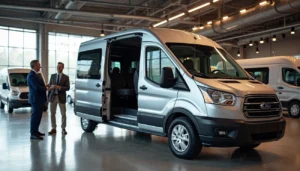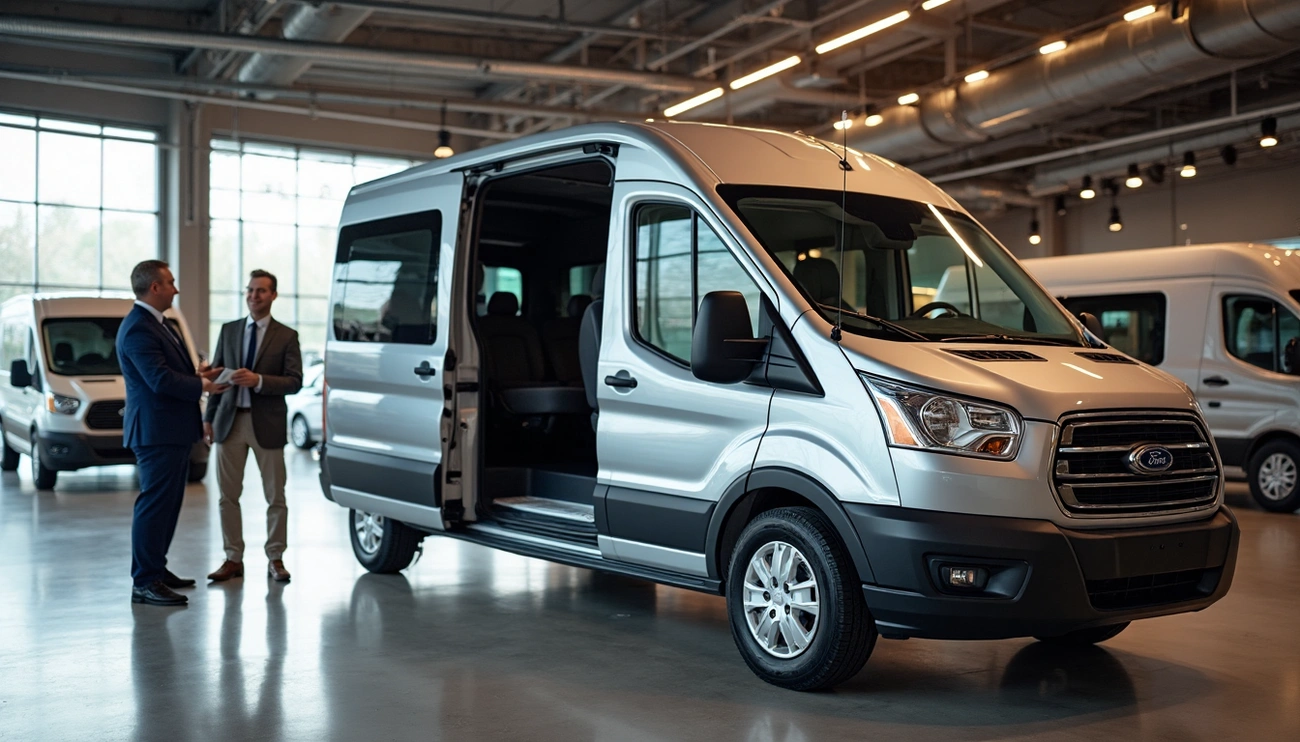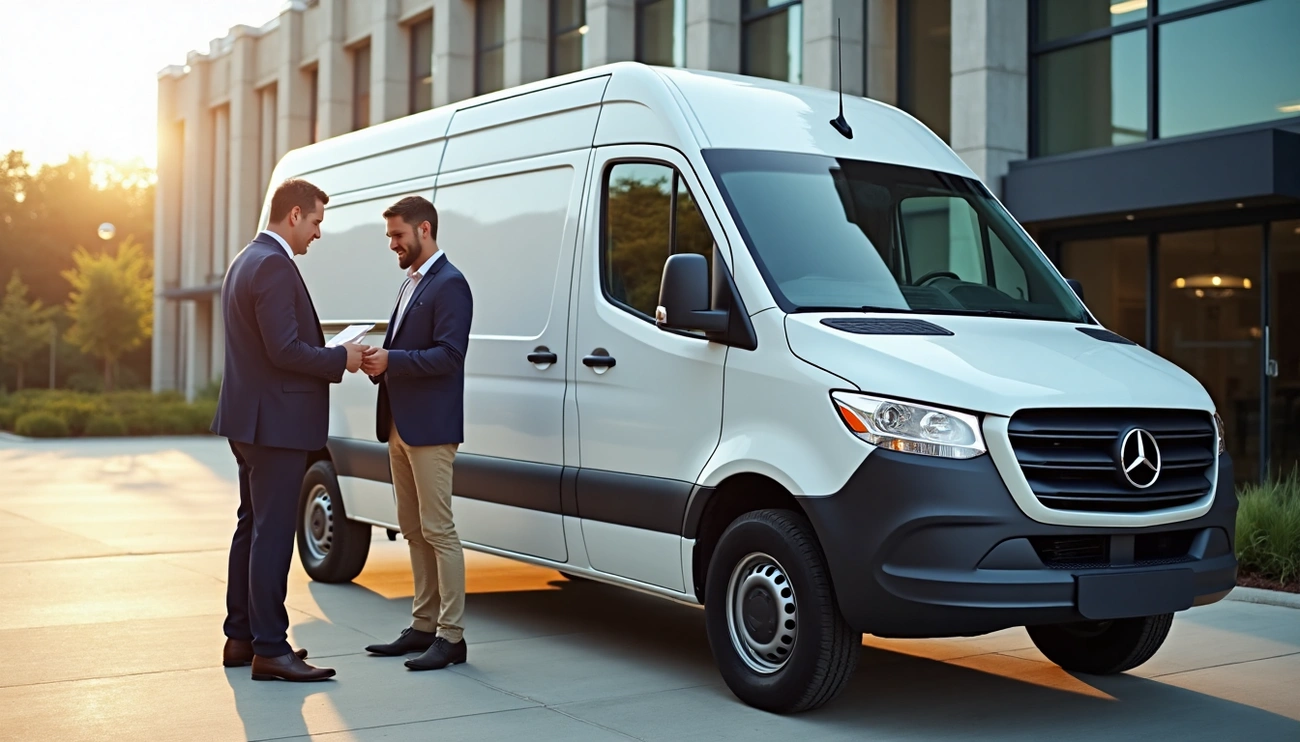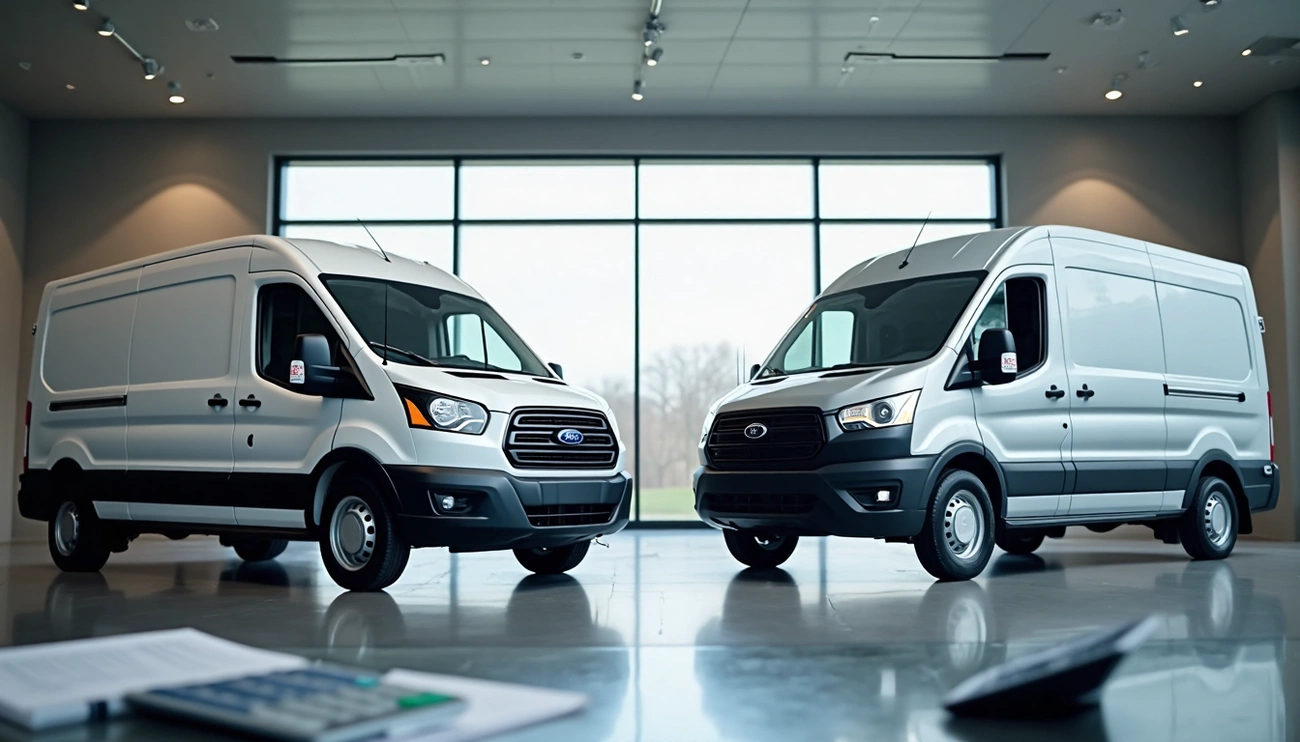Crew Van Leasing Makes Sense
Crew van leasing costs start at £199 per month excluding VAT. This makes it a much more affordable option than buying outright in 2025. Monthly rental costs range between £199 and £499 based on your chosen model. These versatile vehicles provide great value for businesses and if you have specific transportation needs. Source
Crew vans stand out because they combine passenger capacity with cargo space perfectly. You can comfortably transport up to six passengers while keeping plenty of room for equipment and materials. Most crew van lease deals come with removable rear seats. This lets you switch between passenger and cargo setups whenever needed. Our customers love the practical nature of crew cab van leasing, and it has become their top choice for flexible transportation. See all van leasing
Let’s explore why crew van leasing beats buying in 2025. We’ll look at the best features in crew van lease deals and help you pick the right vehicle that matches your needs. Leasing might be your smartest choice this year, whether you need to move your team and tools or want versatile transport options for your business. See Ford Van Lease
What is a Crew Van and Why It’s Popular in 2025
Crew vans bridge the gap between standard panel vans and passenger vehicles. These versatile vehicles differ from traditional vans by offering both cargo space and passenger capacity. Their standout feature lies in the dual-row seating setup that fits 5-6 people with a dedicated cargo area in the back. See business van lease
Definition and key features
Crew vans (also known as double cab vans or crew cab vans) come with a second row of seats behind the driver’s cab that fits three more passengers. The substantial loading space remains intact with strong bulkheads protecting the separate cargo areas. Most models feature side sliding doors so passengers can get in easily, plus wide-opening rear doors that make loading a breeze.
These vans shine because of their modular design. Many crew van lease packages now include removable or foldable rear seats. You can switch between passenger and cargo setups based on what you need each day. This flexibility makes crew cab van leasing a great choice for businesses with changing transport requirements.
Modern crew vans stand out because they’re surprisingly comfortable. The simple, bare-bones interiors are history. Latest models pack climate control, touchscreen infotainment systems, and seats as comfortable as passenger cars. They still carry impressive payloads between 800-1200kg depending on which model you choose.

Who uses crew vans today?
Crew van leasing appeals to many industries. Construction companies and building contractors lead the pack. These vans let them move both work crews and materials to sites efficiently. Plumbers, electricians, and other trades people pick crew vans because they can transport team members and equipment together.
Utility companies and service providers often choose crew cab van lease options, especially if their technicians work in teams. Farming and landscaping businesses benefit from moving workers and tools in one vehicle.
Crew vans have caught on with outdoor activity businesses, film production teams, and event management companies. These groups love being able to transport people and equipment without needing multiple vehicles.
Small business owners are turning to crew van lease deals as economical alternatives to keeping separate commercial and passenger vehicles. This approach helps them streamline processes and cut down on paperwork.
Why demand is rising in 2025 Crew Van Leasing
Crew van leasing has surged in 2025 for several reasons. The post-pandemic economy has made businesses watch their spending. They want transport solutions that work without big upfront costs. Crew van lease deals offer predictable monthly payments instead of large investments.
Cities have stricter environmental rules now, and many have low emission zones. Crew cab van leasing lets businesses use newer, cleaner vehicles without buying them outright.
The gig economy and project-based work create a need for flexible transport that adapts to business changes. Crew vans fit this role perfectly with their versatile functionality and adjustable layouts.
Technology in van design has improved fuel efficiency, comfort, and safety features. These vehicles are way more appealing than older models. Electric crew van options are becoming common, helping businesses meet sustainability goals while potentially saving on running costs over time.
Economic sense, environmental rules, workforce flexibility, and better technology have made crew van leasing an attractive choice for businesses of all sizes in 2025.
Leasing vs Buying: What’s the Real Difference?
Understanding the basic differences between leasing and buying a crew van could save your business thousands of pounds. This choice impacts your balance sheet and gives you different levels of operational flexibility.
Upfront costs and cash flow Crew Van Leasing
The biggest difference between crew van leasing and buying comes down to your first payment. Buying a new crew van needs a big upfront payment or major financing arrangements. Lease deals just need an initial rental payment of 3-6 monthly instalments. This helps keep your working capital free for other business investments.
Let’s look at the numbers: a new medium-sized crew van costs £30,000-£40,000 to buy outright. With leasing, you’ll only put down £1,000-£2,000 upfront and make manageable monthly payments. This helps businesses keep their cash flow healthy while getting the transportation they need.
Small businesses and startups benefit the most from this setup. Leasing removes the big financial barrier that comes with buying, which lets companies get essential transportation without emptying their bank accounts. Many growing businesses pick lease deals to protect their cash during growth phases.
Depreciation and resale value
Vehicles lose value over time, which makes a strong case for leasing. A new crew van loses 15-35% of its value in year one and up to 50% by year three. Buying means you take this entire loss yourself.
The leasing company handles the depreciation risk with crew cab van leasing. Your monthly payments cover the vehicle’s value drop during your contract instead of its lifetime value. You can return the vehicle at the end without dealing with trade-ins or finding buyers in an unpredictable used vehicle market.
Flexibility and contract terms
Today’s crew van leasing offers more options than ownership. Contracts run from 24 to 60 months, so you can update your fleet with newer, more efficient models regularly. Most lease deals let you extend contracts, end early (with fees), and adjust mileage based on your business needs.
Ownership gives you unlimited usage without mileage caps but locks you into one vehicle longer. Leasing lets businesses adapt their transportation as their needs change.
Tax implications for businesses
Crew Van Leasing and purchased vehicles have different tax impacts on businesses. VAT-registered companies get a clear advantage with leasing – they can usually claim back 100% of the VAT on leasing costs. Plus, lease payments count as business expenses against corporation tax.
Buying comes with its own tax benefits:
- You can reclaim initial purchase VAT (if you qualify)
- You can claim capital allowances against taxable profits
- Running costs stay tax-deductible as business expenses
Tax rules change often, so check with your accountant before deciding. The best choice between leasing and buying depends on your business’s financial situation, cash flow needs, and daily operations.
Top Benefits of Crew Van Leasing in 2025
Top Benefits of Crew Van Leasing in 2025
UK businesses increasingly prefer crew van leasing over traditional ownership in 2025. The practical benefits go beyond just financial advantages. Let’s look at why companies are making this choice.
Access to newer models
Crew van lease deals give you the chance to drive the latest vehicles. Your business can use brand-new crew vans with innovative technology and features [191]. Your team will benefit from better fuel efficiency, improved safety systems, and modern connectivity options without owning the vehicle [141].
The process works like upgrading your phone. You can get a new vehicle every few years [183]. This keeps your business looking professional and gives you access to the newest van technology.
Lower maintenance risks
Van owners often struggle with Crew Van Leasing maintenance costs. Many lease deals solve this by including complete maintenance packages that cover regular servicing throughout the lease [161]. These packages cover MOTs after three years, scheduled manufacturer servicing, and breakdown support [161].
Accredited garages and qualified technicians handle all repairs [163]. VAT-registered businesses get an extra advantage – they can reclaim 100% VAT on maintenance costs within the lease agreement [163].
Predictable monthly costs
Business planning needs stable finances. Your monthly payments stay fixed throughout the contract with crew van leasing agreements [183]. This helps you forecast expenses and manage cash flow better [171].
The lease’s maintenance package creates one monthly payment that covers almost all vehicle expenses [161]. Your accounting becomes simpler and your budget stays protected from surprise costs.
No worries about resale
Buying vehicles comes with depreciation concerns. You just return the vehicle when your lease ends, so market value and finding buyers won’t be your problem [181].
This gives you great flexibility. You can pick a new vehicle that fits your current business requirements when the lease ends without selling your old van [183].
Free delivery and warranty perks
Lease deals often come with valuable extras. Free delivery anywhere on UK mainland saves both time and money [191].
The manufacturer’s warranty protects you against mechanical problems during the lease [144]. Some providers add unique features like jet-washable polyshield lining. This strengthens the van’s interior – perfect for businesses using vans in tough conditions [191].
These advantages make crew van leasing a budget-friendly, flexible transport solution for businesses in 2025.
Types of Crew Vans Available for Lease
The crew van market has something for everyone – from nimble city runners to spacious people-movers. Let’s take a closer look at different categories to help you find the perfect crew van lease deal that matches your needs.
Small crew vans Crew Van Leasing
Small crew vans make perfect sense when you need compact yet versatile transportation. The Fiat Fiorino Combi starts at just £159.74 per month for business leasing. The Fiat Doblo crew van comes with a second row of seats while keeping plenty of cargo space. The Citroen Berlingo is another great choice that’s available as a crew van with 1.5BlHDi XL 850 configuration. These smaller models can handle payloads of 700-800kg, making them ideal for light-duty work in city environments.
Medium crew vans Crew Van Leasing
Medium-sized models lead the crew cab van leasing market because they strike the right balance between passenger comfort and cargo space. The Ford Transit Custom double cab comes in L1 and L2 variants and remains a top choice, with lease prices starting at £369 per month. You’ll also find the popular Renault Trafic crew van starting at £325 monthly and the Vauxhall Vivaro XL H1 Double Cab. These versatile vehicles comfortably seat six people and still leave plenty of room for cargo.
Large crew vans
Large crew vans are your best bet when space matters most. The Mercedes Sprinter Tourer line offers short, medium, and long variants with business leasing starting at £338.25 monthly. Peugeot Boxer models give you great value and massive load capacity. These bigger crew vans usually have enough height to stand up in the back and can easily fit bulky equipment along with passengers.
Electric crew vans
Electric crew van choices keep growing in 2025. The Ford Transit Custom electric crew cab (65kWh 136 Limited Auto) shows where the future is heading. If you need something smaller, look at the Citroen e-Berlingo, Peugeot e-Partner and Vauxhall Combo-e – they’ll go up to 170 miles between charges. These models give you all the benefits of a crew van plus lower running costs and less environmental impact.
Popular models in the UK
The Volkswagen Transporter Combi, Renault Trafic Crew and Vauxhall Vivaro Double Cab are the most popular crew van lease deals right now. The Mercedes Vito crew van has also built a strong following, with premium versions starting at £485 monthly. These models have earned their reputation through reliability, comfort, and strong resale values – though leasing makes the last point less important.
How to Choose the Right Crew Van Lease Deal
The right crew van lease can make a big difference to your business. You need to think over several significant factors. A good balance between passenger comfort and cargo space will maximise your investment.
Assessing your passenger and cargo needs
The number of passengers you transport regularly are the foundations of your choice. Construction teams, service technicians, and landscaping crews need 5-6 seats for their daily work. You might want permanent seating or removable rear seats that let you use the whole van for goods when needed.
The payload capacity equals the Gross Vehicle Weight (GVW) minus the kerb weight. To name just one example, a van with a 3000kg GVW and 2000kg kerb weight gives you 1000kg of usable payload. Going over this limit isn’t just illegal – it’s dangerous.
Comparing crew van lease deals
The original payments vary between providers, usually ranging from 1-12 monthly instalments. Each package offers different features. Some providers include extras like jet-washable polyshield lining to strengthen the interior or full UK warranties with breakdown assistance.
Monthly rental costs differ between providers, but price isn’t everything. Maintenance packages are a great way to get servicing, MOTs, and breakdown coverage.
Understanding lease terms and mileage limits
Lease periods typically run from 24-48 months. Short-term deals give you flexibility but cost more monthly, while longer agreements reduce your monthly payments.
Your mileage limits need careful attention. Most agreements come with yearly allowances between 10,000-30,000 miles. Extra miles often cost around 10p each. The predicted mileage should be realistic – look at your previous usage or multiply your monthly average by 12.
Choosing between crew cab van lease and standard lease
Crew cab vans let you move both people and cargo. This makes them perfect if your business needs team mobility and equipment transport. Standard vans give priority to cargo space, which works better when you rarely transport passengers.
These vans shine when you need to take workers to job sites during the week and use them as family vehicles on weekends. That’s the sort of thing I love about crew vans – they’re versatile enough to serve multiple purposes.
Conclusion Crew Van Leasing
Crew van leasing has become a compelling alternative to outright purchase in 2025. The financial advantages make a strong case – monthly payments start from just £199 with much lower original outlays, which helps businesses keep valuable capital for other investments. The company also avoids depreciation risks completely.
The financial perks aren’t the only benefit, as crew van leasing brings remarkable flexibility. Companies can transport both team members and equipment in a single vehicle, which optimises operations for tradespeople, construction companies, and service providers. These vans naturally adapt to your changing business needs with removable rear seating options.
Leasing lets you access newer models that come with advanced safety features, better fuel efficiency, and modern technology without long-term ownership commitments. Fixed monthly payments create stable business planning, and maintenance packages cut down unexpected costs and administrative work.
The available options make leasing even more attractive. You can choose from a compact Fiat Doblo, a versatile Ford Transit Custom, or an eco-friendly electric alternative that matches your company’s specific needs and budget.
The choice between leasing and buying in 2025 depends on your priorities. Businesses looking for economical transportation solutions with maximum flexibility and minimal financial risk will find crew van leasing to be the smarter option. More UK businesses are choosing to lease their crew vans this year because the benefits are clear.
Key Takeaways
Crew van leasing offers significant financial and operational advantages over buying in 2025, making it the smarter choice for businesses seeking flexible, cost-effective transportation solutions.
• Lower upfront costs preserve cash flow – Leasing requires only £1,000-£2,000 initially versus £30,000-£40,000 for purchasing, protecting working capital for business growth
• Fixed monthly payments eliminate depreciation risk – Starting from £199/month, leasing transfers vehicle depreciation burden to providers whilst offering predictable budgeting
• Access to newer technology without long-term commitment – Regular fleet refreshes provide latest safety features, fuel efficiency, and connectivity options every 2-4 years
• Dual-purpose versatility maximises operational efficiency – Crew vans transport both passengers (5-6 seats) and cargo simultaneously, with removable seating for ultimate flexibility
• Comprehensive maintenance packages reduce unexpected costs – Many deals include servicing, MOTs, and breakdown cover, with 100% VAT reclaimable for registered businesses
The combination of financial flexibility, operational versatility, and reduced administrative burden makes crew van leasing particularly attractive for construction companies, tradespeople, and service providers who need to transport both teams and equipment efficiently.




